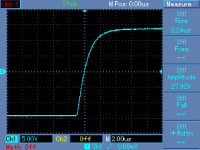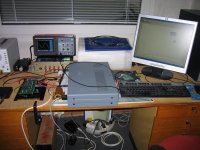Hello Sanders,
Thanks. In the original article they look like Philips PR02 types, which are 2W metal film types. Do you have a part number for the ones you use.
Regards
Arthur
Thanks. In the original article they look like Philips PR02 types, which are 2W metal film types. Do you have a part number for the ones you use.
Regards
Arthur
they look like Philips PR02 types
Good observation! Indeed they are.
VISHAY SFERNICE|PR02-1R 5%|RESISTOR, PRO2 5% 1R | Farnell Nederland
WELWYN|MFP2-1R JI|RESISTOR, 2W 5% 1R | Farnell Nederland
Cheers,
Sander.
I became very curious how this amp, especially the output stage, works. So, I have designed my own PCB with the slightly modified output stage and different driver, for study purposes. I have also improved my measuring methods to be able to measure distortion components down to -130 dBr. Parameters of the ExtremA output stage are stunning. There is nothing to compare with, as long as it stays in class A. Forget all other "popular" class A amplifiers. This one is beyond any compare.
I became very curious how this amp, especially the output stage, works. So, I have designed my own PCB with the slightly modified output stage and different driver, for study purposes. I have also improved my measuring methods to be able to measure distortion components down to -130 dBr. Parameters of the ExtremA output stage are stunning. There is nothing to compare with, as long as it stays in class A. Forget all other "popular" class A amplifiers. This one is beyond any compare.
Hello PMA,
Is it possible to post some measurements THD versus power at different frequencies.
Regards
Arthur
As long as it stays in class A is right.
5 years later mine still sounds great...when in class A and not clipping.
5 years later mine still sounds great...when in class A and not clipping.
I'd be interested in what you used for a front stage Pavel.
Hi Sander,
here is the story. One of the great classical music lovers here had decided to use the ExtremA for a tweeter section of his BIG 3-way active speakers. He bought the modules and another guy assembled them for him. However, they did not reach as good measured parameters as you did and they also had some power supply line mess in their measurements. I suspected a possible measurement issue – you know it is not that easy to measure a piece of audio like this – and possibly sub-optimal wiring. I started to play with the circuit in the simulator and became very curious. My curiosity was concentrated to the output stage, as I have never achieved better results from any other output stage even in simulation.
So I have decided to build your output stage, with current limiting parts (2 transistors and 2 diodes) omitted. I have decided to build a single ended version only, and to check it both outside feedback loop and inside feedback loop, an opamp (OPA627) was added for this purpose. But I was mostly interested in the behavior of the output stage outside the feedback loop, to understand how the output stage behaves in isolation and in reality, not only in simulation.
The next step was to develop a measurement method. My current measurement has ended just a bit below 0.001% THD, which was insufficient to measure ExtremA. So, I have build a measuring system with 2T notch filters (tuned at 1628Hz and 6760Hz, not intentionally exactly these numbers, but part tolerances just resulted in this) and a measuring amplifier with volume regulated by input Alps potentiometer to set appropriate measuring level for soundcard input. With this setup, I was able to get clear measurement spectrum with sensitivity of -130dBr of the individual spectral components. Then I added a correction on 2T filter amplitude response and created a protocol template in Excel.
With ExtremA output stage in FB loop of the OPA627 (overall gain 26.18dB), I got these results:
1628Hz, Vout = 3.536Vrms, Rload = 6.8ohm, THD = 0.00014%
6760Hz, Vout = 3.536Vrms, Rload = 6.8ohm, THD = 0.00038%
Then I measured the output stage in isolation, outside feedback loop, with auxiliary preamplifier (40dB) inserted in front of the ExtremA output stage. The output stage has so low distortion, that it was almost impossible to distinguish its distortion from the distortion of the auxiliary preamplifier.
Results:
1628Hz, Vout = 7.42Vrms, auxiliary preamplifier only, THD = 0.00048%
1628Hz, Vout = 7.42Vrms, Rload = 6.8ohm, preamp + ExA output stage, THD = 0.0006%
The only added distortion with the ExA output stage was at 3rd harmonic line.
Attached is a measurement protocol with OPA627+ExA (in FB loop) and a step response, and a photo of outside-loop measurement setup.
Regards,
Pavel
Attachments
Last edited:
I forgot basic data like power supply 2 x 25V, idle current 1.54A. Ptot = 77W. With the heatsink shown it can be operated up to 10 minutes, then comes the cooling cycle 😉
There is nothing to compare with, as long as it stays in class A.
Does it stay in ClassA?As long as it stays in class A is right.
This is 8W into 6r81628Hz, Vout = 7.42Vrms, Rload = 6.8ohm, preamp + ExA output stage, THD = 0.0006%
Last edited:
7.42Vrms to 6R8 makes 8.1W, please correct your calculation 🙂 OH, you edited the post.
1.54A idle stays in class A till 3.08 A peak output, i.e. 2.18Arms. Please try power calculation to know if it stays in class A or not. 😉
I am sorry guys, not that much time to answer trivial questions and trivial mistakes.
1.54A idle stays in class A till 3.08 A peak output, i.e. 2.18Arms. Please try power calculation to know if it stays in class A or not. 😉
I am sorry guys, not that much time to answer trivial questions and trivial mistakes.
Hello PMA,
Can you post 10 watts into 6.8R load.
Regards
Arthur
Hello Arthur,
sometimes later, I have already dismounted the measurement setup. However, 8W/6R8 result was already mentioned for the output stage outside loop, though affected by auxiliary preamp. 0.00048% preamp itself, 0.0006% preamp + output stage outside loop.
Regards,
Pavel
Conventional ClassA current limit for a push pull output stage is twice the output stage bias current...............................
1.54A idle stays in class A till 3.08 A peak output, i.e. 2.18Arms. Please try power calculation to know if it stays in class A or not. 😉
I am sorry guys, not that much time to answer trivial questions and trivial mistakes.
This is equivalent to 3Apk for 36W into 8r0.
You and Lgreen have both stated
So I'll rephrase the question:As/as long as it stays in class A
Does this amplifier achieve more ClassA than conventional wisdom would tell us?
Is this such a "trivial question"?
Oh, I see. No, calculation is the same as for a standard push-pull class A output stage. Unfortunately, transition from class A to B is abrupt and distortion goes from "nothing" to 0.X% immediately, speaking about output stage in isolation. It is best operated in class A only.
PMA I guess the harmonic structure and "how it sounds" compared to, for example your previous CFP power buffer, would be more interesting data. At least for me 🙂
PMA I guess the harmonic structure and "how it sounds" compared to, for example your previous CFP power buffer, would be more interesting data. At least for me 🙂
Harmonic structure at listening level: 2nd at -122dB, 3rd at -119dB, there is nothing to talk about like distortion. Absolutely smooth step response, output stage is still very good at 1MHz, this amplifier is much better than my class A 12 years ago was. This is a "Sound Reference", to me. No flaws. Perfect from bass to treble. It has an ability to bring the specific concert hall acoustics and reverberations better than anything else I have ever heard.
Harmonic structure at listening level: 2nd at -122dB, 3rd at -119dB, there is nothing to talk about like distortion. Absolutely smooth step response, output stage is still very good at 1MHz, this amplifier is much better than my class A 12 years ago was. This is a "Sound Reference", to me. No flaws. Perfect from bass to treble. It has an ability to bring the specific concert hall acoustics and reverberations better than anything else I have ever heard.
That's exactly what we set out to do, design the proverbial wire with gain, with distortion levels that are better than anything else on the market.
Member
Joined 2009
Paid Member
You have my attention !
I've not found it easy to see what's going on from the Eagle schematic - do you have the schematic in any other format - LTSpice would be ideal ??
I'm looking for a Class A buffer to build a hybrid amplifier.
I've not found it easy to see what's going on from the Eagle schematic - do you have the schematic in any other format - LTSpice would be ideal ??
I'm looking for a Class A buffer to build a hybrid amplifier.
- Status
- Not open for further replies.
- Home
- Amplifiers
- Solid State
- ExtremA, class-A strikes back?

